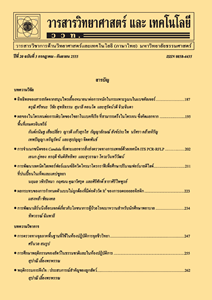การประเมินความหลากหลายทางพันธุกรรมของกล้วยไม้สกุลกุหลาบในประเทศไทยด้วยเทคนิค SRAP
Main Article Content
บทคัดย่อ
กล้วยไม้สกุลกุหลาบหรือเอื้องกุหลาบ (Aerides) จัดเป็นกล้วยไม้ที่มีศักยภาพสูงในการพัฒนาเป็นไม้ตัดดอกหรือส่งออกของประเทศไทย เนื่องจากรูปทรงดอกที่สวยงามคล้ายนก และกล้วยไม้ในสกุลนี้ยังสามารถผสมข้ามชนิดและข้ามสกุลได้ง่าย ด้วยเหตุนี้จึงเกิดสายพันธุ์ใหม่ ๆ ขึ้นมากมายในปัจจุบัน การศึกษาในครั้งนี้จึงมีวัตถุประสงค์เพื่อประเมินความหลากหลายทางพันธุกรรมของกล้วยไม้สกุลกุหลาบในประเทศไทยทั้ง 7 ชนิด เปรียบเทียบกับสกุลแวนด้า 3 ชนิด และสกุลช้าง 2 ชนิด ด้วยเทคนิค SRAP โดยสุ่มเลือกจาก 100 คู่ไพรเมอร์ โดยผลการศึกษาพบว่าไพรเมอร์ SRAP จำนวน 8 คู่ สามารถเพิ่มปริมาณชิ้นส่วนดีเอ็นเอและให้แถบดีเอ็นเอที่ชัดเจนทั้งหมด 164 แถบ ขนาดประมาณ 50-2,000 คู่เบส โดย 163 แถบ เป็นแถบดีเอ็นเอที่พบแตกต่างกันในทุกชนิดที่ศึกษา และเมื่อนำข้อมูลที่ได้มาวิเคราะห์ความแตกต่าง พบว่ามีค่าสัมประสิทธิ์ความเหมือน 0.039-0.891 โดยเหมือนกันน้อยที่สุด คือ กุหลาบขาว 3 กับกุหลาบมาลัยแดง 3 และเหมือนกันมากที่สุด คือ เข็มขาวกับเขาแกะ ขณะที่ในกล้วยไม้สกุลกุหลาบนั้นค่าสัมประสิทธ์ความเหมือนที่มากที่สุด คือ กุหลาบขาว 3 และ 4 (0.625) ดังนั้นจะเห็นได้ว่ากล้วยไม้สกุลกุหลาบนี้มีความหลากหลายทางพันธุกรรมสูงมาก
คำสำคัญ : กล้วยไม้; เครื่องหมายดีเอ็นเอ; ความหลากหลายทางพันธุกรรม
Article Details
References
[2] Chase, M.W., Cameron, K.M., Barrett, R.L. and Freudenstein, J.V., 2003, DNA data and Orchidaceae systematics: A new phylogenetic classification, pp. 69-89, In Dixon, K.W., Kell, S.P., Barrett, R.L. and Cribb, P.J. (Eds.), Orchid Conservation, Natural History Publications (Borneo), Kota Kinabalu.
[3] van den Berg, C., Goldman, D.H., Freudenstein, J.V., Pridgeon, A.M., Cameron, K.M. and Chase, M.W., 2005, An overview of the phylogenetic relationships within Epidendroideae inferred from multiple DNA regions and recircumscription of the Epidendreae and Arethuseae (Orchidaceae), Amer. J. Bot. 92: 613-624.
[4] Doyle, J. and Doyle, J., 1987, A rapid DNA isolation procedure for small quantities of fresh leaf tissue, Phytochem. Bull. 19: 11-15.
[5] กนกรัตน์ พิมพาพันธ์ และเพ็ชรลดา พิลึก, 2552, สภาวะที่เหมาะสมในการสกัดดีเอ็นเอจากใบมะขาม, ปัญหาพิเศษปริญญาตรี, สาขาวิชาชีว วิทยา คณะวิทยาศาสตร์ มหาวิทยาลัยนเรศวร, พิษณุโลก.
[6] Doulis, A.G., Harfouche, A.L. and Aravanopoulos, F.A., 2000, Rapid, high quality DNA isolation from cypress (Cupressus sempervirens L.) needles and optimization of the RAPD’s marker technique, Plant Mol. Biol. Rep. 17: 1-14.
[7] วริสรา แทนสง่า, ธีระชัย ธนานันต์ และนฤมล ธนานันต์, 2557, การจำแนกพันธุ์และการวิเคราะห์ความสัมพันธ์ทางพันธุกรรมของกล้วยไม้สกุลกุหลาบ (Aerides) ด้วยเทคนิคแฮตอาร์เอพีดีและไอเอสเอสอาร์, ว.วิทยาศาสตร์และเทคโนโลยี 3: 103-112.
[8] นฤมล ธนานันต์, ฐิติพร โท้มโสภา และธีระชัย ธนานันต์, 2557, การประเมินความสัมพันธ์ทางพันธุกรรมในกล้วยไม้สกุลหวายกลุ่มเอื้องสายด้วยเครื่องหมายแฮตอาร์เอพีดี, ว.วิทยาศาสตร์และเทคโนโลยี 22: 99-108.
[9] นฤมล ธนานันต์, วริสรา แทนสง่า และธีระชัย ธนานันต์, 2557, การประเมินความหลากหลายทางพันธุกรรมของกล้วยไม้สกุลกุหลาบด้วยเครื่องหมายแฮตอาร์เอพีดี, ว.วิทยาศาสตร์และเทคโนโลยี 22: 317-326.
[10] Li, G. and Quiros, C.F., 2001, Sequence-related amplified polymorphism (SRAP), a new marker system based on a simple PCR reaction: its application to mapping and gene tagging in Brassica, Theor. Appl. Genet. 103: 455-461.
[11] Kaur, S., Ford, R., Nicolas, M., Norton, R. and Taylor, P.W.J., 2004. Selection of parents for studying B tolerance in Brassica rapa, In New Directions for a Diverse Planet: Proceedings for the 4th International Crop Science Congress, Brisbane.
[12] Ferriol, M., Pico, B. and Nuez, F., 2003, Genetic diversity of a germplasm collection of Cucurbita pepo using SRAP and AFLP markers, Theor. Appl. Genet. 107: 271-282.
[13] Suman, A., Kimbeng, C.A., Edma, S.J. and Veremis, J., 2008, Sequence-related amplified polymorphism (SRAP) markers for assessing genetic relationships and diversity in sugarcane germplasm collections, Plant Genet. Resour. C. 6: 222-231.
[14] Youssef, M., James, A.C., Rivera-Madrid, R., Ortiz, R. and Escobedo-Graciamedrano, R.M., 2011, Musa genetic diversity revealed by SRAP and AFLP, Mol. Biotechnol. 47: 189-199.
[15] Luo, Y.X., Du, D.Z., Fu, G., Xu, L., Li, X.P., Xing, X.R., Yao, Y.M., Zhang, X.M., Zhao, Z. and Liu, H.D., 2011, Inheritance of leaf color and sequence-related amplified polymorphic (SRAP) molecular markers linked to the leaf color gene in Brassica juncea, Afr. J. Biotechnol. 10: 14724-14730.
[16] Babaei, S., Talebi, M. and Zeinali, H., 2014, Analysis of genetic diversity among saffron (Crocus sativus) accessions from different regions of Iran as revealed by SRAP markers, Sci. Hort. 171: 27-31.
[17] Xie, Q., Liu, Z., Wang, S. and Li, Z., 2015, Genetic diversity and phylogenetic relationships among five endemic Pinus taxa (Pinaceae) of China as revealed by SRAP markers, Biochem. Syst. Ecol. 62: 115-120.
[18] Inan, N., Yildiz, M., Sensoy, S., Kafkas, S. and Abak, K., 2012, Efficacy of ISSR and SRAP techniques for molecular characterization of some cucurbita genotypes including naked (Hull-less) seed pumpkin, J. Anim. Plant Sci. 22: 126-136.
[19] Cai, X., Feng, Z., Zhang, X., Xu, W., Hou, B. and Ding, X., 2011, Genetic diversity and population structure of an endangered orchid (Dendrobium loddigesii Rolfe) from China revealed by SRAP markers, Sci. Hort. 129: 877-881.
[20] Rohlf, F.J., 2002, NTSYSpc Numerical Taxonomy and Multivariate Analysis System, Applied Biostatistics, Inc., New York, 44 p.
[21] Sneath, P.H.A. and Sokal, R.R., 1973, Numerical Taxonomy. Freeman and Co., San Francisco. 573 p.
[22] มลิวรรณ นาคขุนทด, ศิริรัตน์ อุดอินทร์ และอนุพันธ์ กงบังเกิด, 2015, การจัดจำแนกกล้วยไม้สกุลกุหลาบด้วยเทคนิคพีซีอาร์-อาร์เอฟแอลพีบริเวณดีเอ็นเอในคลอโรพลาสต์, Thai J. Genet. 8: 160-166.
[23] นิรนาม, 2558, เอื้องกุหลาบกระเป๋าปิด, แหล่ง ที่มา : http://www.myfirstbrain.com/stude nt_view.aspx?ID=22105, 21 เมษายน 2558.
[24] Seidenfaden, G., 1988, Orchid genera in Thailand XIV: Fifty-nine Vandoid genera, Opera Bot. 95: 1-357.
[25] Garay, L.A., 1972. On the systematics of the monopodial orchids I, Bot. Mus. Leaf. Harv. Univ. 23: 149-212.
[26] Seidenfaden, G., 1987, Orchid genera in Thailand Vol. Vl, Neottioideae Lindl. Kobenhavn. Dansk. Botanisk. Arkiv. Bind. 32: 116-117.
[27] Christenson, E.A., 1987, The Taxonomy of Aerides and related genera, Proceedings of the 12th World Orchid Conference, Tokyo.
[28] Topik, H., Yukawa, T. and Ito, M., 2005, Molecular phylogenetics of subtribe Aeridinae (Orchidaceae): Insights from plastid matk and nuclear ribosomal ITS sequences, J. Plant Res. 18: 271-284.
[29] Carlsward, B.S., Whitten, W.M., Williams, N.H. and Benny, B., 2006, Molecular phylogenetics of Vandeae (Orchidaceae) and the evolution of leaflessness, Amer. J. Bot. 93: 770-786.
[30] Kocyan, A., de Vogel, E.F., Corti, E. and Gravendeel, B., 2008, Molecular phylogeny of Aerides (Orchidaceae) based on one nuclear and two plastid markers: A step forward in understanding the evolution of the Aeridinae, Mol. Phylogenet. Evol. 48: 422-443.
[31] Tanaka, R. and Kamemoto, H., 1961, Meiotic chromosome behavior in some intergeneric hybrids of the Vanda alliance, Amer. J. Bot. 48: 573-582.
[32] Shindo, K. and Kamemoto, H., 1962. Genome relationships of Neofinetia Hu and some allied genera of the Orchidaceae, Cytologia 27: 402-409.
[33] Shindo, K. and Kamemoto, H, 1963, Karyotype analysis of some Sarcanthine orchids, Amer. J. Bot. 50: 73-79.
[34] Tara, M. and Kamemoto, H., 1970. Karyotype relationships in the Sarcanthinae (Orchidaceae), Amer. J. Bot. 57: 176-182.

